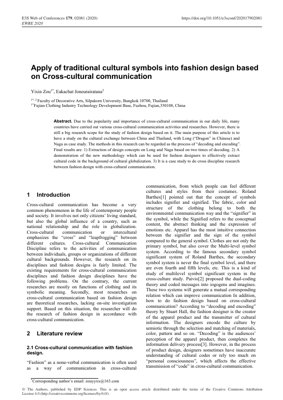Table of Contents
- 1 Introduction
- 2 Literature Review
- 3 Methodology
- 4 Results and Analysis
- 5 Technical Implementation
- 6 Future Applications
- 7 References
1 Introduction
Cross-cultural communication has become fundamental in contemporary society, influencing both daily life and international relations. This research addresses the gap between cross-cultural communication theory and fashion design practice, proposing a structured methodology for cultural symbol integration in fashion.
2 Literature Review
2.1 Cross-cultural Communication with Fashion Design
Fashion serves as non-verbal communication in cross-cultural contexts, allowing cultural expression through clothing. Roland Barthes' semiotic theory provides the foundation for understanding fashion as a multi-level symbol system.
2.2 Semiotic Theory in Fashion
According to Barthes, clothing contains both signifier (materials, colors, structure) and signified (conceptual content, emotions). The research applies Stuart Hall's encoding-decoding theory to fashion design process.
3 Methodology
3.1 Decoding-Encoding Framework
The research employs a two-stage decoding process for Chinese Long and Thai Naga symbols, followed by encoding into fashion design elements. This ensures accurate cultural representation.
3.2 Dual-Coding Theory Application
Paivio's dual-coding theory is applied, processing cultural information through both verbal (logogens) and non-verbal (imagens) systems for comprehensive cultural transmission.
4 Results and Analysis
4.1 Design Concept Extraction
Successful extraction of design concepts from Long and Naga mythology through systematic decoding. Key elements include serpentine forms, scale patterns, and cultural narratives.
4.2 Cultural Code Transmission
The methodology demonstrates effective cultural code transmission through fashion design, addressing previous issues of cultural misinterpretation in cross-cultural fashion.
5 Technical Implementation
5.1 Mathematical Formulation
The cultural transmission efficiency can be modeled as: $E_{ct} = \frac{\sum_{i=1}^{n} C_i \cdot D_i}{\sum_{i=1}^{n} C_i \cdot M_i}$ where $C_i$ represents cultural elements, $D_i$ denotes design integration, and $M_i$ represents cultural misinterpretation factors.
5.2 Code Implementation
class CulturalSymbolDecoder:
def __init__(self, cultural_elements):
self.elements = cultural_elements
def decode_symbols(self):
# First decoding: Cultural analysis
cultural_codes = self.analyze_cultural_context()
# Second decoding: Design extraction
design_elements = self.extract_design_elements(cultural_codes)
return design_elements
def encode_design(self, design_elements):
# Encode into fashion design
fashion_collection = FashionCollection(design_elements)
return fashion_collection.generate()6 Future Applications
The methodology can be extended to other cultural symbol pairs in fashion design. Potential applications include AI-assisted cultural analysis tools and virtual fashion design platforms for cross-cultural collaboration.
7 References
1. Barthes, R. (1967). Elements of Semiology. Hill and Wang.
2. Paivio, A. (1971). Imagery and Verbal Processes. Holt, Rinehart & Winston.
3. Hall, S. (1973). Encoding and Decoding in the Television Discourse. Centre for Contemporary Cultural Studies.
4. Zhu et al. (2017). Unpaired Image-to-Image Translation using Cycle-Consistent Adversarial Networks. ICCV.
Critical Analysis
一针见血: This research attempts to bridge fashion design with cross-cultural communication theory, but fundamentally struggles with the same issue it identifies - the gap between theoretical frameworks and practical design implementation remains substantial.
逻辑链条: The paper establishes a clear theoretical foundation using Barthes' semiotics and Hall's encoding-decoding model, then applies Paivio's dual-coding theory to fashion design. However, the transition from theoretical models to practical design methodology lacks the rigor seen in established computational approaches like CycleGAN's unpaired image translation, which provides concrete mathematical frameworks for style transfer.
亮点与槽点: The strength lies in recognizing fashion as a multi-level symbol system and proposing a structured decoding-encoding process. The case study of Chinese Long vs. Thai Naga provides concrete cultural comparison. However, the methodology lacks quantitative validation and relies heavily on subjective interpretation. Unlike computational approaches that use discriminators to evaluate style transfer quality, this research provides no objective metrics for cultural accuracy assessment.
行动启示: Fashion designers should adopt more rigorous computational methods from computer vision research. The field needs standardized evaluation metrics for cultural accuracy in design, similar to how CycleGAN uses cycle consistency loss $L_{cyc}(G,F) = E_{x~p_{data}(x)}[||F(G(x))-x||_1] + E_{y~p_{data}(y)}[||G(F(y))-y||_1]$ to ensure meaningful translations. Future work should integrate objective cultural analysis tools with subjective design evaluation to create truly effective cross-cultural fashion methodologies.
